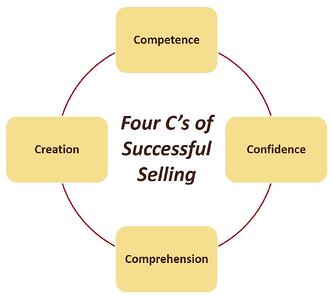 Being successful at conducting sales conversations is not something that requires loads of training or preparation. Yes, you want to have the right tools on your training tool belt so you can be prepared, but you don't need to hold back from tackling sales success due to your intimidation or the lack of knowing some of the basics of selling. Basically, you just have to keep it simple (like we instructed in the K.I.S.S. ("Keep it simple, stupid!") article about customer service), and you will find it's easier than you think to simply be a sales rock star.
Being successful at conducting sales conversations is not something that requires loads of training or preparation. Yes, you want to have the right tools on your training tool belt so you can be prepared, but you don't need to hold back from tackling sales success due to your intimidation or the lack of knowing some of the basics of selling. Basically, you just have to keep it simple (like we instructed in the K.I.S.S. ("Keep it simple, stupid!") article about customer service), and you will find it's easier than you think to simply be a sales rock star.
 Before we visit the four-step approach, let's first lay our foundation by quickly revisiting the "Four C's of Successful Selling" (yes, it seems we like things in fours!). It would be sloppy and ridiculous for you to even consider talking to a potential customer if you don't first feel good about your abilities with these 4 C's...
Before we visit the four-step approach, let's first lay our foundation by quickly revisiting the "Four C's of Successful Selling" (yes, it seems we like things in fours!). It would be sloppy and ridiculous for you to even consider talking to a potential customer if you don't first feel good about your abilities with these 4 C's...
-
Competence: You must be able and capable to speak about your company and its products.
-
Confidence: You must have confidence in yourself and your selling abilities. What's holding you back?
-
Comprehension:You must fully understand and be able to accurately speak to all details in regards to your products and services.
-
Creation: You must have a script or practiced verbiage for all of your key selling points.
Mastering the 4 C's means you can remove those training wheels so you can focus on the Four-Step Sales Process. Here are the four simple steps:
Step 1 ~ Complete Pre-Work- When you are able, prior to every sales encounter, make sure that you determine what key message points you want to cover and what your next-step objective will be. Create a standard list for yourself, upon which you can build catered to each specific situation, that includes your game plan for how you will build rapport, what questions you need to ask, what feedback and benefits you will outline, and how you will close each interaction.
Step 2 ~ Conduct the Meat of the Sales Conversation- Show up on time, with a smile, and truly engage the prospective customer so you can build a relationship with trust. Lead a conversation, not a sales presentation. Make sure that you keep all of your notes from "pre-work" in front of you so you stay on target. It's also imperative that you take notes about what you learn about the customer.
Step 3 ~ Firm Up the Next Step at the Close of the Sales Conversation- During "pre-work" you determined what your desired outcome will be, so do what you can to guide your prospect to this next step. Get the customer to commit to something specific rather than leaving anything on the table that is vauge or left up in the air. For example, set a date and time for the next touch point and confirm what additional information you will send as follow-up. When possible, create a sense of urgency and intrigue so the emotions of the purchase will be heightened.
Step 4 ~ Complete Post-Work- Ensure that all of your hard work leading up to this step is not discounted. All of those notes you took during steps 2 & 3 need to be appropriately logged and accounted for, and all next steps must be added to your calendar so that all tasks get done on time. Be sure to, in the least, send the prospect an immediate "thank you" email to show your appreciation of their time. Then, take care of any follow-up efforts that you said or want to conduct, and be certain to continue to "touch" the customer so you will be not be "out of sight and out of mind."
One thing that you must always keep in mind is that selling is all about the customer and has nothing to do with you. Let this guide and lead you throughout the entire customer engagement. Happy selling!


